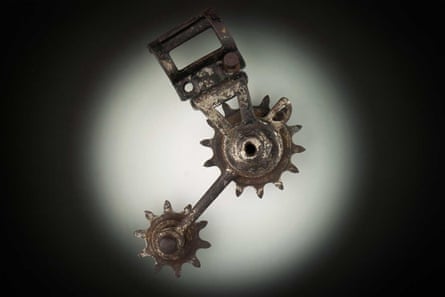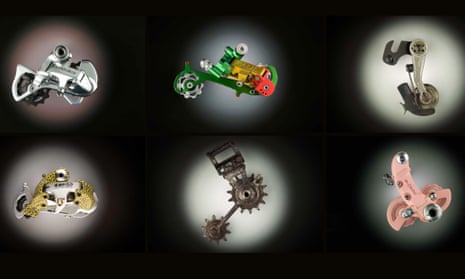If your bike has gears, the chances are it also has derailleurs. These mechanical marvels which move the chain when you move up or down a gear may be a small part of the bicycle, but the myriad designs reveal a lot about the history of cycling. Over the nearly 40 years I’ve spent working in bike shops, I have collected about 1,400 rear derailleurs. Here are just 10 of the most influential, interesting or just plain weird.
Le Chemineau, France, 1912

There are a few possible claimants for the title of “inventor of the derailleur”, but there is only one candidate for the position of “godfather of the derailleur”. That is Paul de Vivie, who was better known by his pen name Vélocio. Vélocio published an influential magazine called Le Cycliste, was a key founder member of the Touring Club de France (the French version of the CTC, the RAC and the AA, all rolled into one) and was an enthusiastic, non-smoking, vegetarian at a time when this was virtually unthinkable.
But Vélocio’s true importance was that he was among the first Frenchmen to understand that there was the cut and thrust of racing cycling, there was everyday utility cycling for transport but there was also something else – a kind of cycling that was about unalloyed freedom, the simple pleasure of exercise in the fresh air, away from the crowded polluted city, a zen activity in which you competed against nobody but yourself. The view from the top of the climb was the only prize you required. Vélocio called this type of cycling “cyclotourisme”.
Vélocio’s love of “cyclotourisme” led him to explore variable gearing, but with a healthy scepticism about hub gears with their fixed gear ratios and their multiplicity of tiny, fragile, parts. This drew him, step by step, to the derailleur.
Vélocio was an inveterate inventor, and hand-crafted any number of different derailleurs. Finally, one of his friends, Joanny Panel, took one of Vélocio’s designs and developed it into a commercially successful product – the 1912 Le Chemineau derailleur. It brought together many of the elements of modern derailleurs – two pulley wheels mounted on a sprung arm moving the chain across a multiple freewheel, controlled by a cable and a lever mounted by the handlebars.
Vélocio was run over by a tram in St Étienne in 1930 and is commemorated by a monument at the top of the Col du Grand Bois, a local hill that he liked to cycle up to test his derailleur designs.
Vittoria Giuseppina, Italy, 1948

Vittoria was a derailleur manufacturer established by Tommaso and Amadeo Nieddu in Turin in the late 1920s. At the time Benito Mussolini was energetically rebranding Italy as a military super-power . In support of this aim, one Giovanni Agnelli, a notable fascist and founder of the Fiat motorcar company, decided to build a massive statue of the winged goddess of Victory on top of the highest hill in Turin.
Inspired by this, the Nieddu brothers chose Vittoria as the brand name for their new, modern and very successful derailleur company and adopted the winged goddess as their logo. It is easy to forget that many engineers, including bicycle engineers, were enthusiastic fascists.
Kharkov, Ukraine, 1968

This humble object is a copy of the classic 1953 Campagnolo Gran Sport derailleur, manufactured by the Kharkov Bicycle Factory in Ukraine. The Kharkov factory produced many of the Soviet empire’s better bicycles and many of the components that they used. But that was not the full extent of its talents; it also manufactured the wheels of the astounding Lunokhod robot vehicles that trundled around the surface of the moon in the early 1970s.
Huret Jubilee, France, 1974

To celebrate the 50th anniversary of its founding in 1920, the French company Huret decided to create the ultimate derailleur – and in 1970, that meant lightweight. The result was the Jubilee – a masterpiece of minimalism unsurpassed to this day. Grooves on the tiny adjustment screws, the pulley wheels with adjustable ball bearing races and the world’s lightest steel Allen key hanger bolt.
This example is a very well used, 1974, long-cage version that weighs 145g, without a hint of titanium or carbon. It’s an honourable effort considering that a modern Shimano XTR M9000 GS weighs around 220g.
Campagnolo Nuovo Valentino Extra, Italy, 1976

You can’t have a post on derailleurs without featuring at least one Campagnolo model. This is the humble 1976 Nuovo Valentino Extra, a basic, steel, derailleur designed for Italian volume bike manufacturers to fit to their mid-market models.
But Campagnolo trying to do mass-market derailleurs was a bit like the British royal family trying to do marital fidelity – it was never going to work, because, although they knew they should do it, they considered the whole idea inherently beneath them.
Most startling is Tullio Campagnolo’s weird decision to name something so average, and that seemed of so little interest to him, after his son Valentino. Dino Ferrari may have died young, but at least Enzo Ferrari named one of the greatest sports cars of all time after him.
Ofmega Mistral, Italy, 1982

The 1980s were a strange time – not least for European bicycle component manufacturers. They had ruled the world, unchallenged, for decades, and then suddenly the demand, prestige and respect that they had come to expect all evaporated. Japanese was in, and European was out. Desperate times call for desperate measures, and Ofmega of Italy were more than ready to answer that call with the 1982 Ofmega Mistral.
This derailleur may have the appearance of a sex toy but it is, in fact, a professional quality Italian derailleur. The pink colour celebrates the maglia rosa traditionally worn by the leader of the Giro d’Italia. And despite being pink, plastic and vaguely suggestive, it actually functioned rather well.
Paul Powerglide, US, 1995

By the 1990s mountain bikes had established total dominance of the cycling world. Bike shops once sold 20 mountain bikes for each road bike that went out the door. And this dominance exposed an existential problem – mountain biking was fiercely Californian, forged in the furnace of individuality and exceptionalism that characterises that state – but the hardtail bikes of the time were astoundingly similar to each other. And without exception they were clothed in a near identical suit of Shimano components. Rockshox, Shimano Deore XT and a 7000 series aluminium frame – where’s the individuality and exceptionalism in that?
Enter the Paul Powerglide, the definitive US made bike-porn derailleur of the mid 1990s. It looked amazing: the colours, the CNC geometric shapes, the detailing around the adjustable cable outer stop and the adjustment screws – all of this was like water in the desert for mountain bike aficionados drowning in a sea of lookalike Shimano.
SRAM ESP 9.0, US, 1996?

SRAM Corporation was founded in 1987 in Chicago, Illinois. Its first product was a plastic twist-grip gear control that rapidly became very popular, particularly on low-end mountain bikes. But then it had a rush of blood to the head – and decided to take on the might of Shimano and develop a complete line of bicycle components. It was a brave business strategy – but it seems to be working out so far. In derailleur terms, SRAM has introduced some notable innovations and has kept Shimano on its toes. And you don’t see many leopard-skin derailleurs.
EGS Up Cage, France, 1998

When a market gets bland and homogenised you can often look to France for some light relief. The EGS Up Cage was a masterpiece of incredible but doomed euro-technology in the fine tradition of the Citröen DS and the Concorde airliner. First find a blind alley, then charge up it at maximum speed, all the while deploying astounding creativity, inimitable panache and a reluctance to compromise on anything, least of all quality.
The Up Cage was a fascinating design. The lower run of chain was close to the underside of the chainstay, ran over the top of the upper tension pulley, through the pulley cage and under the bottom of the lower tension pulley, and then up over the top of the guide pulley – and if you understood all that, you are probably French.
Not only was the design classy, the quality of construction was a marvel in its own right.
Shimano Dura-Ace (7700 GS), Japan, 2001

If you can’t have a post on derailleurs without featuring at least one Campagnolo model, you certainly have to feature at least one Shimano. And while there are many important models, I have chosen to feature the Shimano Dura-Ace 7700 GS. The 7700 series was not a ground breaking Dura-Ace generation. Unusually, Shimano acknowledged this by giving it a polished finish that was deliberately retro. But what was new was the inclusion of a “GS” long cage derailleur.
With the introduction of this model, Shimano finally gave in to the inevitability of having to sell its top-of-the-line groupset to fat middle-aged men who want low, low gears. Its appearance indicated that the portly wallets of portly gentlemen counted for more than the alluring image of speed, youth and fitness that Shimano had carefully cultured for Dura-Ace over two and a half decades.
It was a triumph of beer-fueled reality over EPO-fueled fiction. Blessed are the middle-aged and portly, for we have already inherited the earth.
- Mike Sweatman is giving a talk titled A History of the World in 100 Derailleurs at the Pleasance Theatre in Edinburgh at 3pm on Sunday 10 June. Tickets can be bought here. More of Mike’s collection can be seen on his website, Disraeli Gears.

Comments (…)
Sign in or create your Guardian account to join the discussion